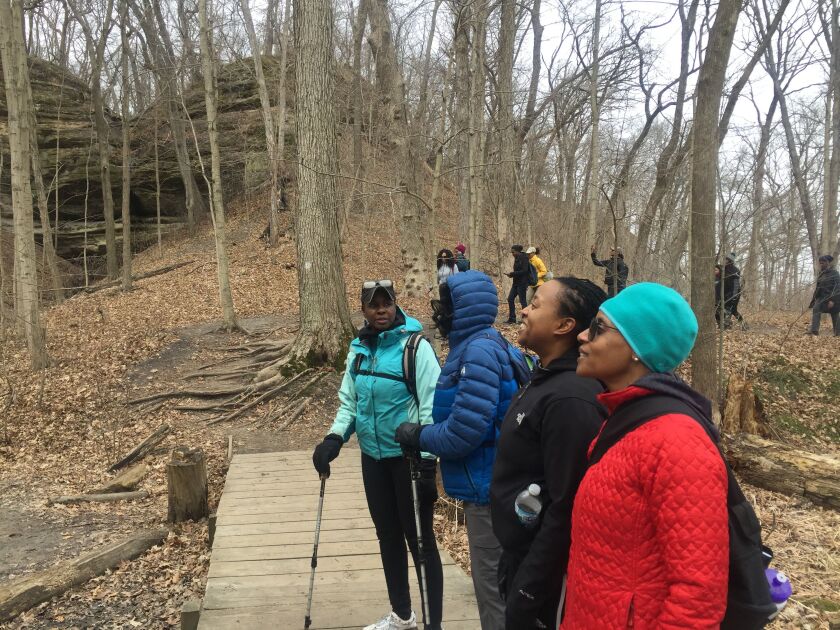Christine Meissner’s favorite moment on the annual Camping 101 trips she leads around Chicago is seeing “people transform over two days.”
The trips, hosted by the Chicago and Northwest Indiana chapter of Outdoor Afro, teach skills such as pitching a tent and making a fire, and “pretty much 100 percent [of] people who come have never camped at all,” she said. But by the end, many are planning their next excursion with their families.
“When I see and hear the transformation in people, then I know they have really made the reconnection to nature,” Meissner, one of three chapter leaders, said in an email.
Outdoor Afro, a national nonprofit, aims to connect Black people with nature and cultivate Black leadership outdoors. Chapters around the country organize outdoor activities, including hiking, canoeing, birding, rock-climbing, ice skating, sailing and biking. In the winter, it’s cold-weather experiences, such as snow-shoeing and skiing, or indoor events like archery or a trip to a natural history museum.
Since March, when the coronavirus pandemic shut down most recreational sites across the country, including state and national parks, the group has had to adapt its activities to adhere to COVID-19 restrictions.
“[We] became ‘Indoor Afro,’” Meissner said, as the chapter shifted to offering guided meditations online, focusing on images of nature. Then, as lockdown guidelines were eased, there was socially-distanced yoga in the Beaubien Woods.
“[The events] were really powerful actually,” Meissner said, referring to the “therapeutic properties” of nature in the face of national turmoil.
Although Meissner usually sees new participants at every event, the group she leads has seen interest in membership grow even more as the spotlight from anti-racism protests nationwide has heightened attention on Black-led organizations.
Despite this new attention, Outdoor Afro and its goals are not new, said the organization’s communications director, Yanira Castro.
“The point [has always been] Black joy, and having that space. There’s just more people who are interested.”
The national organization began in 2009 as a blog and Facebook page created by Bay Area outdoors-lover Rue Mapp, who wanted to make the outdoors a welcoming space for Black people after she saw few other Black people on her hikes and camping trips.
Now the group has chapters in 30 states, with 90 leaders nationwide — Chicago is the group’s third largest network, according to Meissner, and currently has three leaders in the area.
Its predominantly Black membership of all ages reflects the opposite of the stereotypical portrait of an outdoorsy type. “If you conjured up an image of what an outdoors person looks like, [it’s] usually a white dude in his 20s,” said Castro.
Historically, though, Black people have had a long relationship with nature that has been stymied by racism and violence, said Naomi Davis, founder of the environmental advocacy organization Blacks in Green.
The skills Africans had as craftspeople and crop growers were “exploited” after they were enslaved and brought to America, said Davis. But some Black communities resisted this by forming Maroon communities consisting largely of escaped slaves, who “lived 100 percent on, in, of, and by the land,” said Davis.
Later, she said, Black landowners also had their land stolen in a variety of ways, by the Ku Klux Klan and by county officers through legal methods. Then came the Great Migration, when African Americans moved up North and left their land due to racist Jim Crow laws.
The idea that “the threat was so real that you would walk away and leave your land is a hard concept to understand unless you’ve ever seen a person lynched and set on fire, for fun,” said Davis.
Oboi Reed, president and CEO of Chicago nonprofit Equiticity, which advocates for racial equality in transportation, said, “After slavery, there was Jim Crow, there was redlining, restrictive covenants, disinvestment, racial profiling through police.”
These cause issues of safety that have sometimes stopped Black people from adventuring outdoors, said Reed — including police harassment, and worry about “forest officers accosting you because you don’t look like you belong,” said Reed.
“Why Outdoor Afro is so important is it helps Black people to come to grips with their human right to explore nature.”
By taking explorations together, Outdoor Afro provides a group that people can join to feel safe, and if they want, to become leaders or teach their families and friends in what Meissner called a “multiplying effect.”
“When people start to see themselves reflected outside, they feel more comfortable,” said Meissner. “We’re creating a network like a family.”
Meissner, who has been a Chicago leader for four years, started as a participant because she wanted to find community. “I had done a lot of camping and I was always the only Black person,” she said. She also wanted to take “ownership” of her experience with nature, and learn skills that would help her feel confident exploring the outdoors independently.
After the first event, she knew immediately that “this is my group, I’m going to be part of this for long time.”
The chapter Meissner leads is set to host a Healing Hike on Aug. 23 at the Fort Sheridan Forest Preserve. Healing Hikes began when Michael Brown, an 18-year-old Black man, was shot to death in Ferguson, Missouri, in 2016— the hikes gave people a space for solace by “get[ting] together and hav[ing] those deep emotions,” said Castro.
Most Outdoor Afro activities are free or as low-cost as possible to allow open access. And the group’s membership is not exclusive — one of the group’s sayings, Castro pointed out, is, “You don’t have to have an afro to be an outdoor afro.”
However, said Castro, other participants must have “the understanding that these events are centered around Black folks.”
Outdoor Afro’s Chicago chapter mainly organizes events through MeetUp but also posts about its activities and advice in its Facebook group.










